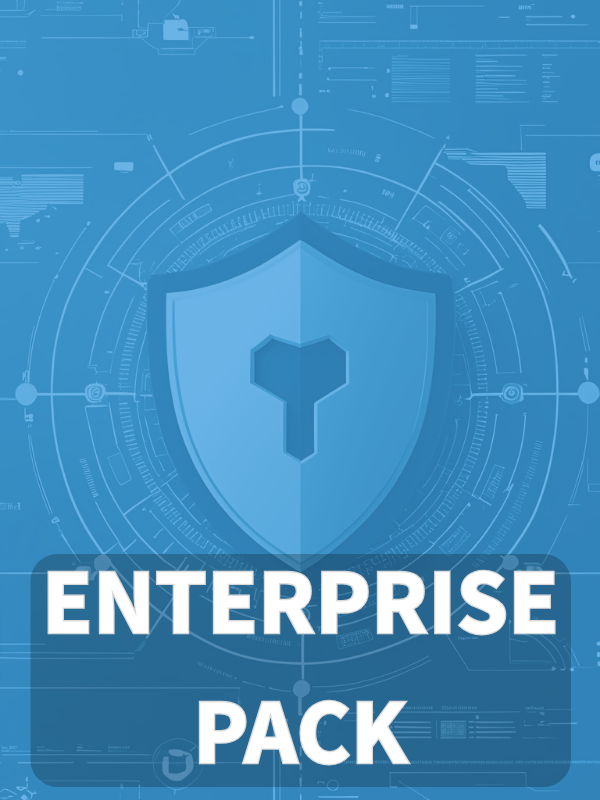Overview
The ISMS Startup Pack - ENT bundle delivers key foundational policies for information security governance, access management, risk, change control, and backup/restoration, designed for audit-readiness and regulatory compliance in line with ISO/IEC 27001:2022 and major frameworks.
Comprehensive Security Foundation
Covers all critical domains: governance, access, change, risk, and data backup, ready for 27001:2022 certification.
Aligned With Leading Standards
Policies map directly to ISO/IEC 27001:2022, NIS2, DORA, GDPR, COBIT, and NIST for regulatory and client assurance.
Audit-Ready Documentation
Centralized, version-controlled, and traceable for quick audits and seamless compliance across all major frameworks.
Clear Roles and Responsibilities
Defines accountability at every level, executive management, IT, end users, audit, and third parties.
Ready to Deploy
Structured, implementation-ready templates for fast-track ISMS, tailored for enterprise environments.
Read Full Overview
What's Inside
Formal Information Security Policy
Roles & Responsibilities Governance Model
Access Control and Identity Management
Change Management Process
Risk Management Framework
Backup and Restore Requirements
Framework Compliance
🛡️ Supported Standards & Frameworks
This product is aligned with the following compliance frameworks, with detailed clause and control mappings.
| Framework | Covered Clauses / Controls |
|---|---|
| ISO/IEC 27001:2022 | |
| ISO/IEC 27002:2022 | |
| NIST SP 800-53 Rev.5 | |
| EU GDPR |
Article 5(1)(f)Article 5(2)Article 24Article 25Article 32Recital 39Recital 49Recital 78
|
| EU NIS2 | |
| EU DORA | |
| COBIT 2019 | |
| ISO/IEC 27005:2024 |
Full risk lifecycle methodology
|
| ISO 31000:2018 |
Risk management principles and framework
|
| NIST SP 800-30 Rev.1 |
|
| NIST SP 800-39 |
|
Related Policies
Governance Roles And Responsibilities Policy
This policy defines the governance model, organizational roles, and responsibilities required to operate an effective Information Security Management System (ISMS).
Information Security Policy
This policy defines the organization’s overarching commitment to information security through the establishment of a formal Information Security Management System (ISMS).
Access Control Policy
This policy establishes mandatory principles, responsibilities, and control requirements for managing access to information systems, applications, physical facilities, and data assets across the organization.
Change Management Policy
This policy establishes a formal framework for initiating, assessing, approving, implementing, and reviewing changes to the organization’s information systems, infrastructure, applications, and related processes.
Risk Management Policy
This policy establishes a unified and formalized framework for identifying, analyzing, evaluating, treating, monitoring, and reviewing information security risks across the organization.
Backup And Restore Policy
The purpose of this policy is to define the mandatory requirements for the backup and restoration of data, systems, and applications to support operational resilience, data integrity, and business continuity.
About Clarysec Policies - Mini Bundle: ISMS Startup Pack - ENT
Effective security governance requires more than just words; it demands clarity, accountability, and a structure that scales with your organization. Generic templates often fail, creating ambiguity with long paragraphs and undefined roles. This policy is engineered to be the operational backbone of your security program. We assign responsibilities to the specific roles found in a modern enterprise, including the CISO, IT Security, and relevant committees, ensuring clear accountability. Every requirement is a uniquely numbered clause (e.g., 5.1.1, 5.1.2). This atomic structure makes the policy easy to implement, audit against specific controls, and safely customize without affecting document integrity, transforming it from a static document into a dynamic, actionable framework.
Frequently Asked Questions
Built for Leaders, By Leaders
This policy was authored by a security leader with 25+ years of experience deploying and auditing ISMS frameworks for global enterprises. It's designed not just to be a document, but a defensible framework that stands up to auditor scrutiny.
